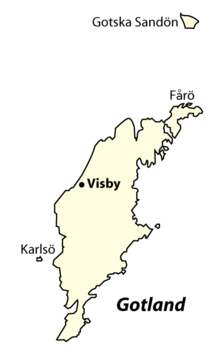This is an old revision of this page, as edited by Karmosin (talk | contribs) at 11:03, 11 July 2005 (→See also: Self-redirect removed.). The present address (URL) is a permanent link to this revision, which may differ significantly from the current revision.
Revision as of 11:03, 11 July 2005 by Karmosin (talk | contribs) (→See also: Self-redirect removed.)(diff) ← Previous revision | Latest revision (diff) | Newer revision → (diff) For other uses, see Gotland (disambiguation).
Template:Infobox Landskap
Gotland is the largest island in the Baltic Sea. At 2,994 km² it is also the largest island belonging to Sweden, ahead of Öland. Inhabitants of the island number 57,381 (2002 figure) and the primary income sources are tourism and agriculture.
It is also a historical Province or landskap, of Sweden. It consists of the islands of Gotland, Fårö and a few smaller islands located in the Baltic Sea to the east of Öland.
County
For current affairs see: Gotland County
The island province of Gotlandia is represented by the current administrative entity, Gotland County. The island is also a single municipality.
History
Main article: History of Gotland

Early on Gotland became a commercial center and the town of Visby was a the most important Hanseatic city in the Baltic Sea. The island had in late medieval time twenty tings, each represented at the island-ting, called landsting, by its elected judge. New laws were decided at the landsting, which also took other decisions regarding the island as a whole. The city of Visby and rest of the island was governed separately and a civil war caused by conflicts between the German merchants in Visby and the trading peasants on the countryside had to be put down by King Magnus I of Sweden in 1288. In 1361, Waldemar Atterdag of Denmark invaded the island. Victual Brothers occupied the island in 1394 to set up a stronghold headquarters on their own in Visby. At least Gotland came as a fiefdom to the Teutonic Knights to fight Victual Brothers at their fortified sanctuary. An invasion army of the Teutonic Knights conquered the island in 1398, destroyed Visby and drove the Victual Brothers out of Gotland. The authority of the landsting was successively eroded after the island was occupied by the Teutonic Order, then sold to Eric of Pomerania and after 1449 ruled by Danish governors. In late medieval time the ting consisted of twelve representatives for the farmers, free-holders or tenants. Since the Treaty of Brömsebro in 1645 the island remains under Swedish rule.
Geography
Main article: Geography of Gotland

The province of Gotland consists of the islands of Gotland, Fårö, the Karlsö Islands and Gotska Sandön. The main island is located some 90 km off the Swedish mainland.
Visby, founded approximately around the year 1000, was the only chartered city of Gotland.
- National Parks: Gotska Sandön
Culture
Main article: Culture of Gotland
The medieval town of Visby has been entered as a site of the UNESCO World heritage program. An impressive feature of Visby is the fortress wall that surrounds the city, dating from the time of the Hanseatic League. Christopher Polhem (1661-1751), the father of Swedish mechanical physics was born in Visby. He was also called the Archimedes of the north. The inhabitants of Gotland traditionally speak a distinct dialect of Swedish, known as Gutnish.
Traditional games of skill like Kubb and Varpa are still played in Gotlandia.
Heraldry
Main article: Heraldry of Gotlandia
Gotland was granted its arms in 1560, even though the island was at the time occupied by Danish forces. The coat of arms is represented with a dukal coronet. Blazon: "Azure a ram statant Argent armed Or holding on a cross-staff of the same a banner Gules bordered and with five tails of the third."
Dukes of Gotlandia
Since 1772, Swedish Princes have been created Dukes of various provinces. This is solely a nominal title.
- Prince Oscar (from his birth in 1859 until his loss of succession rights in 1888)
See also
- Gotland County, or Gotlands län - a current County of Sweden
- Gotland Municipality, or Gotlands kommun - a current Municipality of Sweden